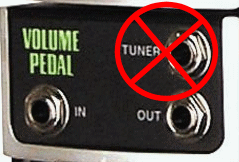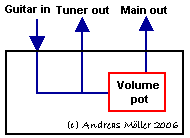
The title is part joke, part truth. They aren’t evil, of course, but the ”tuner out” jack on your volume pedal can do serious harm to your tone. To understand why, we first need to dispel a myth.
”Using the tuner out jack means that the tuner is out of the signal path.”
This couldn’t be more wrong. Yes, the tuner is out of the direct, serial path (meaning that the signal in its entirety doesn’t pass through it), but it is definitely not out of the way. Let’s look at how the ”tuner out” jack is wired:

The signal enters the volume pedal, and is immediately split into two paths. One path leads through the volume pot and out through the output jack, while the other goes straight to the ”tuner out” jack, feeding the tuner. This looks deceptively like a parallel connection, doesn’t it? And furthermore – if we view the volume pot as a circuit (which it is, albeit a simple one) – it looks exactly like the parallel connection that causes wahs and old Electro-Harmonix pedals to suck so much tone…
Now, to find out why this type of setup can cause tone loss, we need to dig a little deeper into the technical stuff. The tuner out simply places the tuner’s input stage in parallel with the input stage of the next pedal – as well as the pot in the volume pedal itself – as the above drawing shows. As most of us know from hooking up speakers, impedances wired in parallel drop to half what they were – two 8 ohm speakers in parallel end up being 4 ohms total. The same rule applies here, but to input impedances. Hold that thought, while we go over the basics of signal impedances.
Impedance?
This will be a very crude introduction, but enough to (hopefully) help you understand the concept. Basically, the input impedance of any given unit (a pedal or amp) needs to be considerably larger than the output impedance of the unit driving it (the guitar or the pedal immediately in front of the unit mentioned earlier). The ratio of difference determines how easily the signal is passed forward, among other things. As the two impedances get closer, more and more signal is lost in the transition, starting with the treble. As an example, many effects pedals have an input impedance of about 500Kohm (to fit the relatively high output impedance of the guitar), while their output impedance is usually less than 10kohm (to make sure the signal will survive the next input stage, even if that input impedance is less than ideal).
Ok, it got a little technical. But basically, for a guitar with regular passive pickups (no batteries or preamps in the guitar) to be able to successfully drive an input stage, the input impedance of that input stage really should be 500Kohm or more. Adding a 250Kohm volume pedal to that doesn’t help things in itself – even before we do anything else, you should be able to hear some loss in the top end. Now, let’s hook the tuner up to the ”tuner out” and see what happens… If the input impedance of the tuner is 500Kohm, and the pedal that follows the volume pedal also 500Kohm, their combined input impedance becomes 250Kohm, which – when we also add the the pot in the volume pedal itself – is starting to be way too low.
Assuming the tuner and the pedal following the volume pedal has 1Mohm input impedance helps a little, but only slightly. While the two 1Mohm impedances make 500K when placed in parallel – which we just determined to be an ok load – once again that 250K load from the volume pedal’s pot is the biggest deciding factor. So the total load only rises a little (from 125K to 166K), in this scenario.
However, all of this is based on the assumption that the volume pedal/tuner is placed first in the chain – if you stick a buffered pedal (Boss/Ibanez or similar) in front of the volume pedal, the scene changes completely. Then, the input impedance facing the pickups will be that of the Boss-type pedal, while the low impedance output from the same pedal (10K or less, as mentioned earlier) will be much better at dealing with the input impedance it encounters.
Solutions
Basically, there are four ways to properly hook up a tuner:
- A/B box – this method disconnects the tuner completely when it is not in use. If you’re not using it to alter or improve the sound, why keep it in the chain? As a bonus, assuming the box is wired correctly, the amp will also be muted when you’re tuning. When you need to change guitars, or just keep the rig quiet in between breaks, you can simply activate the tuner to keep it quiet. If you’d rather hear yourself tune up, you can go for the true bypass box instead. That way, you can route the tuner’s output back through the rig.
- Run the signal through the tuner – a Korg DT-10 has a pretty good buffer system – as has the TC Polytune 3 and Mini 3, and of course the Boss TU-2/3/3W tuners – that might actually help your tone (especially if your board is all true bypass and you often play with all pedals off). But it can’t do its thing from the ”tuner out” – you need to run the signal right through the thing instead, to take advantage of the buffer. Of course, if you’d rather have the tuner completely out of the signal path, just make sure it is true bypass (Polytune 2/Mini 2, or Polytune 3/Mini 3/Boss TU-3W set to true bypass mode).
- Stereo output on one of the pedals – if you have a buffered (Boss-type) pedal with stereo outputs, you can feed the tuner off the unused stereo output. The main drawback to this method is that these kinds of pedals rarely live at the front of the chain (where the tuner would ideally be placed), so you may have to turn off pedals in front of it to get a clean signal to the tuner.
- Use the tuner out on the volume pedal – yes, actually 🙂 You need to make sure there’s a buffered (Boss type) pedal in front of the volume pedal – then this setup works. Ideally, though, you should also consider using a 25K (Boss ”L” model) volume pedal in this scenario, since it will have a smoother sweep when buffered. Or you can…
- …use a buffered volume pedal, like the Ernie Ball MVP or Lehle Mono Volume.